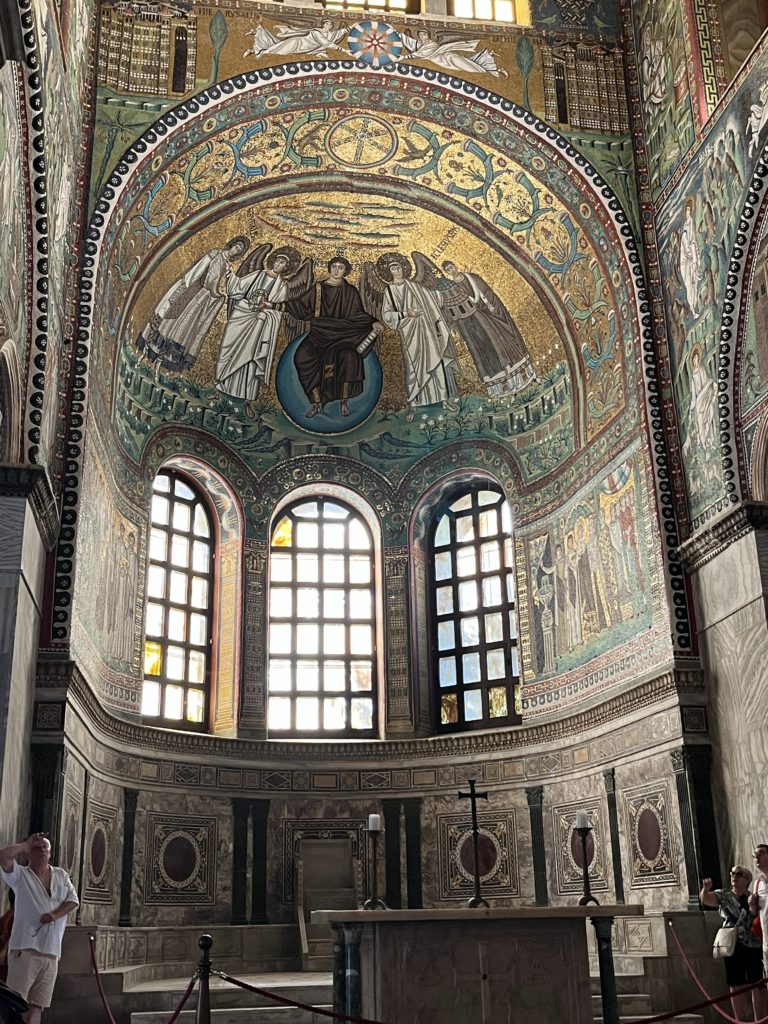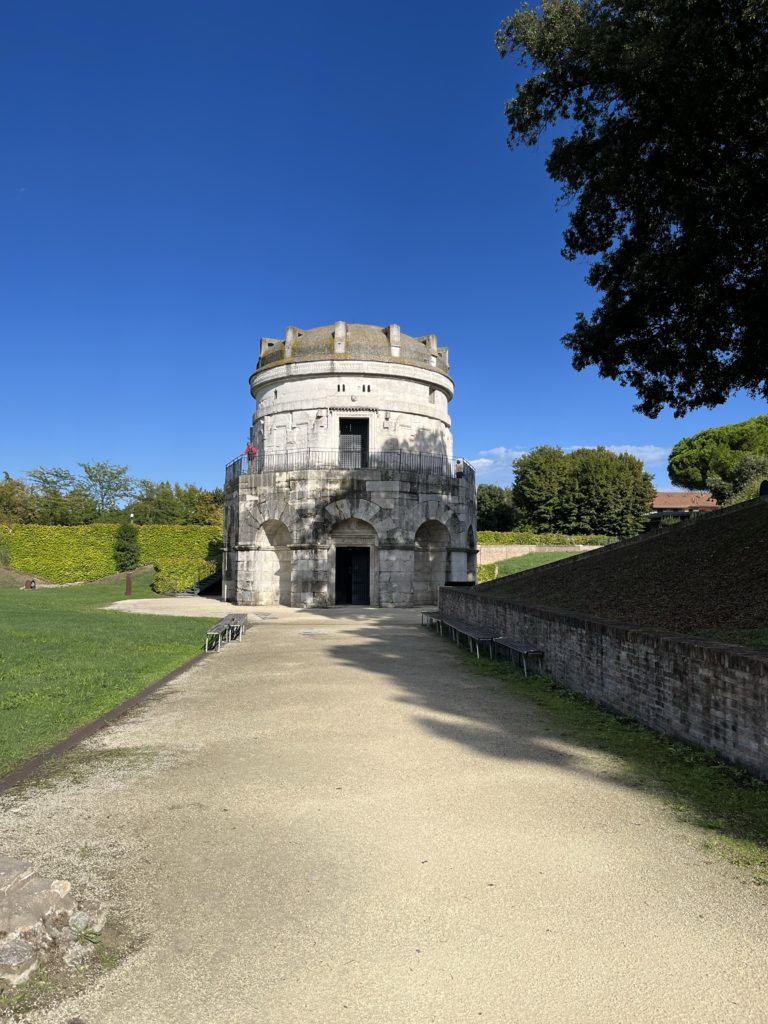
Our first stop of the day was the Palace of Theodoric, 50 feet from the front door of our hotel. The facade is still standing, along with some parts of interior walls. It is connected to the Church of St. Apollinaire we visited yesterday. Perhaps the proximity of the church to the palace says something about Theodoric’s devotion to God, but I’m merely speculating.
Old town Ravenna is for walkers, although what remains of it is surprisingly spread out. We walked 15 minutes to our second stop: the Mausoleum of Galla Placidia. Galla Placidia was the daughter of Theodosius I and was taken hostage by the Arian Visigoth King, Alaric, when he sacked Rome in 410 A.D. She later married Alaric’s successor, Ataulf, but after he was murdered, she was returned to her brother, Emperor Honorius. She then married Constantius III. Honorius and Constantius III both died, leaving Galla Placidia Regent for her young son Valentinian III, and effectively Empress of the Western Roman Empire. She was a remarkable woman, and her rule likely extended the life of the Roman Empire in the West. But her life, like Savonarola’s, is an example of the cost of greatness in the Kingdom. Her Mausoleum contains her tomb, that of her husband, Constantius III, and son, Valentinian III.
The Basilica of Saint Vitale was started by Arians but finished in 547 A.D. by Byzantines after they recaptured Ravenna. The most famous mosaics in the world of Justinian and Theodora are in the apse. The octagonal design of the church repeatedly turns one’s attention toward the altar and its surrounding mosaics, as one walks among the columns on the inside perimeter of the church. It reminded me of Charlemagne’s cathedral in Aachen, Germany, and I wondered if Charlemagne saw San Vitale when he was in Ravenna and whether that inspired his building of the Aachen cathedral. I did a little research, and sure enough that is exactly what happened.
While at St. Vitale, The Wife found the well (over which the church was originally built) where, in the 2nd century A.D. under the reign of Marcus Aurelius, Saint Vitalis was martyred by being buried alive. For this find The Wife received a battlefield promotion to Chief of Research of the GSB Research Division. She seemed satisfied with the title, even though it came with no additional compensation.
Next we walked across town to the Neon Baptistry, named not for the presence of neon lights but because it was completed in the 5th century by Bishop Neon of Ravenna. The baptistry has a tub more than sufficient for a good Southern Baptist dunking of the most portly of converts, which is still the way the Eastern Orthodox baptize, unlike the Catholics who have departed from Jesus’ example and adopted sprinkling.
A stone’s throw from the Neon Baptistry is the Archeological Museum, which housed the Chapel of St. Andrea and the mother of all relics, two thorns from Jesus’ crown of thorns . . . . allegedly. Credit to our new Chief of of the GSB Research Division, who first located this alleged relic, proving the wisdom of my promotion of her just thirty minutes prior.
At lunch we had an invigorating discussion regarding Mariology. This has been a recurring subject on this tour, particularly after the visit to the Ulfiizzi museum, where it seemed every other painting was of Mary. But after a robust discussion at lunch we decided the church went off the rails beginning with the Council of Ephesus in 431 A.D., which decided it appropriate to refer to Mary as “the mother of God.” We also denounced the doctrines of the immaculate conception (that Mary was conceived without original sin), her perpetual virginity (see Mark 20:31) and sinlessness (see Romans 3;23), and her assumption. We affirmed her favor with God and that she should be honored (see Luke 1:26-28, 30), but proclaimed she should not be prayed to or worshipped. Having finally resolved these issues that have plagued the church for centuries, we declared the Council of Ravenna closed, paid our tab, and departed for the Arian Baptistry.
At the Arian Baptistry, we ran into a local who spoke no English whatsoever. When he didn’t understand what I said, I said it gain louder and slower. I think I got this idea from Chris Tucker in Rush Hour. A travel tip for those readers who might travel to Italy in the future: this works no better than speaking English with an Italian accent (see Day 8 post).


The Arian Baptistry depicts the baptism of Jesus in the Jordan in a beautiful mosaic in the ceiling, and experts have opined on the difference between the Arian portrayal of this event and Orthodox portrayal of the same event on the ceiling in the Neon Baptistry as indicative of theological differences (i.e clean-shaven v. bearded), but who knows; there is always a temptation to read too much from too little, when not a lot is available.
By approximately 3:00 p.m. we had seen almost everything on our list, so we decided to mount our chariot (made by the fine German engineering descendants of Theodoric at Mercedes-Benz) and drove about five minutes to the Basilica of St. Apollinaire in Classe, not to be confused with the Basilica of St. Apollinaire Nuovo, which we saw Day 11 in Ravenna. Saint Apollinaire was supposedly a disciple of Peter and was commissioned by him as the Bishop of Ravenna. Saint Apollinaire was martyred under the reign of Roman Emperor Vespasian. For relic enthusiasts, the bones of St. Apollinaire are apparently kept in the walking space under the altar, which is gated. When we were there, entry was not permitted.

Lastly, we visited the Mausoleum of Theodoric, completing the Theoderic circuit (baptistry, church, palace, tomb). The mausoleum was smaller than I imagined from the pictures I had seen and the mosquitos more numerous. I reminded the GSB team that Ravenna is surrounded by what used to be a swamp. Long pants or mosquito repellant is recommended.
After the Mausoleum of Theodoric, we drove the 6 miles to the Adriatic coast to look for a place to eat with a view, but we were not successful and returned to Ravenna for a fine dinner in town.
Overall it was a very productive and enjoyable day. GS
